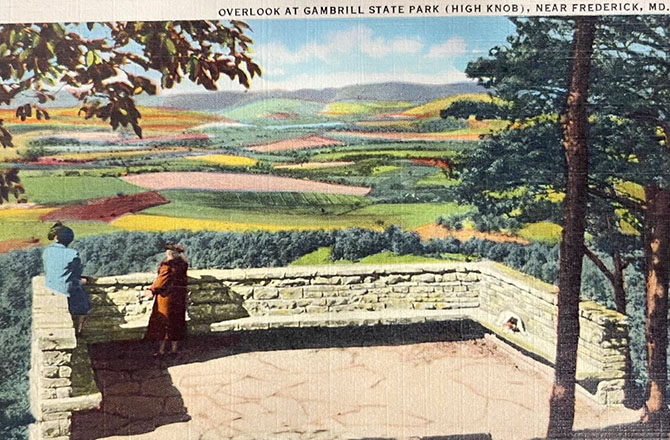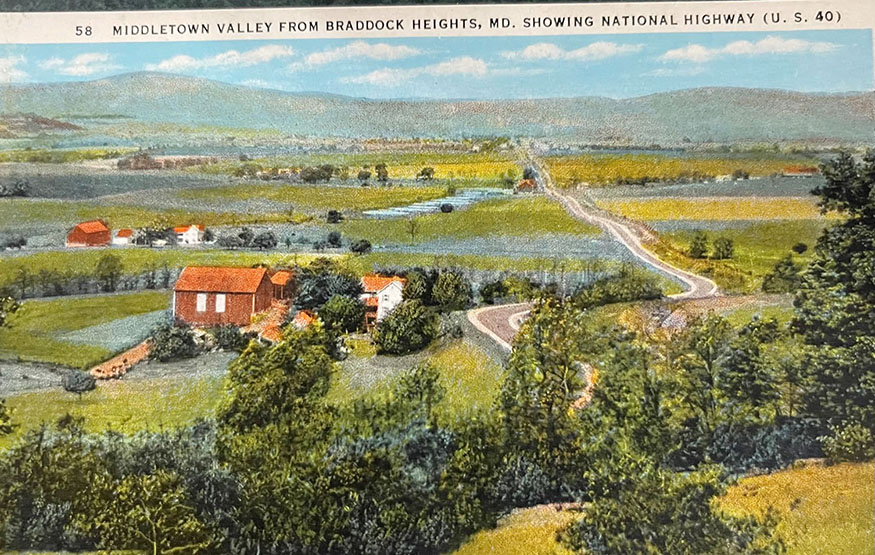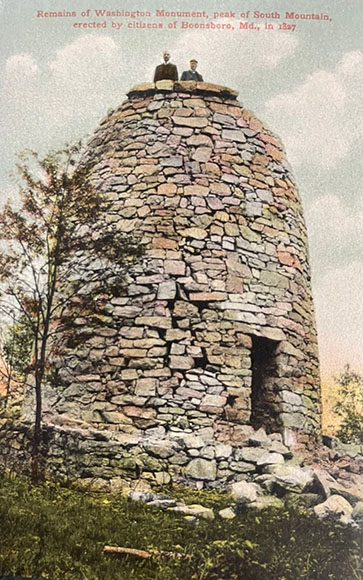“The National Road”
(US 40A)
JoAN bittner FRY

While perusing information for books I wrote, I was intrigued by the history of the National Road. This road links centuries of American history. Taverns and towns that are over 250 years old and mountain passes that were of strategic importance during the Civil War can be found on over 25 miles of this old road. If you’re looking for a day trip this summer, you may want your children or grandchildren to help plan a mystery trip to investigate the wonders close by.
Begin with the wonderful Mason Dixon Welcome Center on Route 15 in Emmitsburg, the South Mountain Welcome Center on Route 70 in Myersville, and/or the internet. As you travel, wonder about the miles and miles of straight road between Frederick and Middletown and ponder how this could be done with horses and men and very few hand tools and without modern equipment.
Climb the first Washington Monument in Boonsboro, see Gathland State Park and the War Correspondents Memorial Arch honoring Civil War correspondents, the overlook at Gambrill State Park, Braddock Heights (which was an amusement park in the 1920s), or the WWI Doughboy statue in Funkstown.
Let your passengers be your guide and don’t forget Potomac Street Creamery in Boonsboro or More Ice Cream (was Main’s) in Middletown. Take a picture to send to The Catoctin Banner. Next time you may want to go to Cumberland on the National Road.
Middletown
Just west of Frederick, Route 40 splits in two: the old road and Route 70. Bear left and take US 40A, which is the old road. Stay on US 40A for this trip. In the early 1900s, travelers stayed at motor lodges or tourist cabins, such as the former Barbara Fritchie Cabins in Frederick.
Middletown is a small village near the base of South Mountain, west of Frederick. It was the center of activity in the days before the Battle of Antietam. In September of 1862, Union and Confederate forces would march along the National Road through the town. US 40A crosses South Mountain at a point called Turner’s Gap. It was there, along with nearby Fox’s and Crampton’s Gaps, that the Battle of South Mountain was waged on September 14, 1862. The battle, which was a Union victory, is called by some the “Prelude to Antietam,” which would occur three days later near Sharpsburg.
The Middletown Valley was a north-south route that brought German immigrants to the area. This German heritage is evident in Middletown’s two Lutheran Churches, as well as Christ Reformed Church, built in 1818, and Zion Lutheran Church, built in 1859.
There is plenty more history at Turner’s Gap besides being a battle site in the Civil War. First, the Appalachian Trail crosses the National Road there. The Old South Mountain Inn has seen plenty of history since it was built in 1732. Many dignitaries in early American history once stayed here, including Henry Clay, who many consider the father of the National Road. The tavern was commandeered by John Brown’s militia before his raid on Harpers Ferry. During the Battle of South Mountain, it served as headquarters for Confederate General D. H. Hill. Today, South Mountain Inn is well known throughout the area for its fine dining.
Boonsboro
Sitting west of Turner’s Gap is the town of Boonsboro. The National Road through Boonsboro has historical significance because a 10-mile section here was the first to be built with a macadam surface in 1823. The process, named for John Loudon McAdam, greatly improved the quality of the National Road, and by 1830, 73 miles of the highway had been converted to a macadamized surface. The method simplified what had been considered state-of-the-art up to that point. Single-sized aggregate layers of small stones, with a coating of binder as a cementing agent, were mixed in an open-structured roadway.
The First Washington Monument
Boonsboro was founded in 1792. The town prospered in the 1830s when the National Road was alive with westbound horse and wagon traffic that kept its blacksmith shops and 82 stores busy, and its inns and taverns filled with travelers and teamsters. Boonsboro has the distinct honor of being the first town or city in America to dedicate a monument to George Washington. Standing on South Mountain 1,200 feet above the town of Boonsboro, it commands a view of overwhelming beauty of the Cumberland Valley and several counties of West Virginia.
Early on the morning of July 4, 1827, two years before the completion of the majestic shaft on Mount Vernon Place in Baltimore, the patriotic citizens of Boonsboro assembled in the town square and marched to the “Blue Rocks” high above the town and by the heaving and hauling of heavy limestone rocks, nearly completed a memorial 54 feet in circumference and about 20 feet in height dedicated to the Father of Our Country. The day was spent in hard work, the men stopping only briefly for a noonday meal and rest. Heavy stones were moved and put in place, many of them weighing as much as a ton. Before nightfall, several Revolutionary War veterans climbed its crude stairway and fired a volley of musketry from the top of its masonry.
The monument, once in ruin, was rebuilt in 1936 by the Civilian Conservation Corps (CCC), which was in existence from 1933-1943. It is easily accessible a short distance off Route 40A, two miles east of Boonsboro. This quaint but impressive monument, built by the hard toil of inspired men, testifies to the fervid patriotism and loyalty of Maryland citizenry.
The CCC was a public work relief program that operated from 1933 to 1943 in the United States for unemployed, unmarried men from relief families, ages 18-28. James McEntee was the head of the agency. A part of the New Deal of Franklin D. Roosevelt, it provided unskilled manual labor jobs related to the conservation and development of natural resources in rural lands owned by federal, state, and local governments. The CCC was designed to provide employment for young men in relief families who had difficulty finding jobs during the Great Depression while at the same time implementing a general natural resource conservation program in every state and territory. Maximum enrollment at any one time was 300,000; in nine years 2.5 million young men participated in the CCC, which provided them with shelter, clothing, and food together with a small wage of $30 a month ($25 of which had to be sent home to their families).
From Boonsboro, follow US 40A to Funkstown, noticing the beautiful Pennsylvania-German bank barns with their limestone-faced gable ends. In Funkstown, find the Doughboy Monument to WWI veterans.
Dahlgren Chapel
Across from the South Mountain Inn and bordered by the Appalachian Trail is The Dahlgren Chapel. Dahlgren is located at the summit of Turner’s Gap in Western Maryland between Middletown and Boonsboro. The Gothic Revival stone chapel was built in 1881 and was consecrated as the Chapel of St. Joseph of the Sacred Heart of Jesus. Most of the building materials came from the immediate area of the site, while a marble altar was imported from Italy.
The chapel was built for Sarah Madeleine Vinton Dahlgren, daughter of Congressman Samuel Finley Vinton, who had married Admiral John A. Dahlgren, inventor of the Dahlgren gun in 1865. John A. Dahlgren designed the 9-inch “soda bottle” gun combining greatly improved ballistic characteristics with a higher safety factor. Dahlgren guns were muzzle loading naval artillery designed by Rear Admiral John A. Dahlgren (1809-1870), mostly used in the period of the American Civil War. Admiral Dahlgren died in 1870. In 1876, Mrs. Dahlgren, who was a noted author, purchased what is now the Old South Mountain Inn and transformed it into a private residence.
After a period under the ownership of the Sisters of the Holy Cross from 1922 to 1925, the chapel returned to the Dahlgren family. It was purchased in 1960 by Richard G. Griffin who undertook a restoration.
The property was acquired by the Central Maryland Heritage League in 1996.
The chapel is included in Turner’s and Fox’s Gaps Historic District but as a non-contributing structure, owing to its post-Civil War construction, which places it outside the historic district’s time of historic emphasis.

Middletown Valley from Braddock Heights, MD, showing National Highway (U.S. 40).

Remains of Washington Monument, peak of South Mountain, erected by citizens of Boonsboro, MD, in 1827.
Courtesy Photo of Postcard

